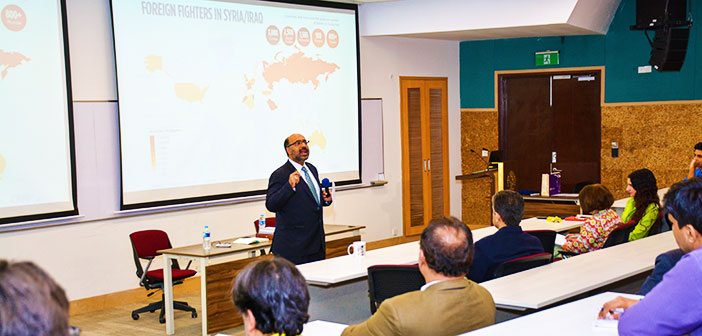KARACHI, November 24, 2015: Habib University’s Yohsin Center for Social Development (YCSD) and Office for Global Engagement (OGE) hosted a Public Lecture with Dr. Hassan Abbas – Professor and Chair of the Department of Regional and Analytical Studies at National Defense University in Washington, DC. on November 24th. Bringing with him great insight into the examination of geopolitical roots of the expanding chaos in the Middle East as well as Saddam Hussein’s legacy, he led a riveting discussion at the Tariq Rafi Hall, this being the third and final lecture of the current semester at Habib University.
Led by the moderator of the Public Lecture, Dr. Hafeez Jamali, the event started off with an introduction of Dr. Hasan Abbas. Listing out his career trajectory, the moderator spoke of his professional and academic achievements, also informing the audience of how Dr. Abbas has remained a former member of the Board of Trustees at Habib University.
Dr. Abbas took the stage with great enthusiasm, commenting on his delight at being back at Habib University, at “seeing the dream turn into reality”. To delve into the state of Iraq and ISIS currently, he listed out three questions:
- Who is behind ISIS, what inspires these young radical Muslims to be sympathetic to the ideology of ISIS?
- How do we understand the rise of ISIS, is it a symptom or a cause?
- What inspires these nearly 200,000 young people, with their foreign schooling and further education from regions such as France, UK, US, Middle East and so on, to drop everything and fight for the “cause”?
In order to answer these questions, Dr. Abbas set up a historical context for his audience, where he mapped out the ethnic identities of the current population of Iraq. He said that each of these identities have their own sense of rights, of what they’re entitled to and where they belong. He spoke of how, since the middle of 2014, one third of Iraq is under the control of ISIS, while one fifth of the entire population live in the area controlled by them. Furthermore, 10,000 people were butchered just in the last year by ISIS, while 200,000 remain internally displaced. Nearly 2 million refugees make up this area, thus why would the population that does turn to ISIS, do so?
To gain a deeper understanding into the occupation of Iraq, Dr. Abbas revealed four factors. One is the historical context, the second is legacy, the third is occupation and the fourth is the regional factor. All of these combined have led Iraq to its current state, which is that of upheaval and chaos, total lack of governance, a political identity as a state accepting refugees from other Middle Eastern nations when it has absolutely no need to, and the brutal violence which leads to more acts of violence as revenge. Dr. Abbas prompted his audience to explore why people across the world are going to Syria to join ISIS, but not willing to fight for Palestine.
To conclude his lecture, Dr. Abbas stated the fact that each of the factors explained above are historical, and factual. “Where there is a dysfunction of state and governance, there’s chaos and violence. People tend to misuse the idea of justice in Islam, and I believe things will remain bad in Iraq as long as it is not a federation”.




